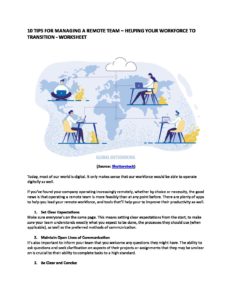The concept of working from home has steadily been growing in popularity over the last several years, but in light of recent events, it’s suddenly been fast tracked for most companies.
With social distancing measures in place, and “stay at home” being the order of the day, even going to work has become a potential threat. Many states are quickly moving to a shutdown of everything except essential services, and most retailers and brick-and-mortar businesses don’t fall into that category.
This means a significant change in the way companies are run. It’s not just business as usual anymore, right now, companies are rushing to accommodate and shift their business model, or else run the risk of shutting the doors altogether.
One silver lining amidst all of the chaos though, is that today, working remotely is more feasible than ever before. These days, there are plenty of apps available to make overseeing a remote workforce easier than ever. Not to mention tools that’ll help your remote team to maximize their productivity.
Today, most of our world is digital. It only makes sense that our workforce would be able to operate digitally as well.
While a work from home transition might seem like a lot of extra work all at once, the rewards far outweigh the costs. The challenges are different, for sure, but once you’re up and running, operating remotely isn’t any harder than running everything in-house.
Let’s take a look at a few reasons why allowing your team members to work remotely can benefit your business, as well as some tips and tools that are essential for remote operations.
Benefits of a Work From Home Workforce
In addition to the fact that these days, the ability to work from home is quickly becoming something of a necessity, there are a number of ways that working from home can benefit both your company and your team.
Take a look:
You Can Choose the Best Talent
When you enable employees to work from home, you are not limited to the staff in your area any longer. That means if the best person for the position is in Seattle and your business is in Milwaukee, you can still hire them. The idea of relocating, especially in such uncertain times, can be a deterrent for a potential employee to take a position.
This gives you the leg up when it comes to finding the best potential employees. Just be sure to take time zones into consideration when setting deadlines and meetings, other than that it should be relatively smooth sailing.
Additionally, when you’re operating remotely, you’ll be able to hire your team members on an as-needed basis. Instead of having only full-time and part-time, you can hire contract workers as well, like a virtual assistant, for added flexibility and to gain the right skills exactly when you need them.
Increased Productivity
Another benefit of allowing employees to work from home is an increase in productivity. According to one study from Stanford University, there was a 13% increase in productivity for those who were able to work from home. Maybe this is because of the fewer instances of sick days or higher satisfaction.
Or maybe most people simply work better when they have a certain level of freedom and autonomy. Either way, the evidence shows that employees who can work remotely tend to be more productive –something that can benefit your business.
Better Employee Retention
More and more people are drawn to the flexibility and relaxed setting that remote work can offer. For one thing, there’s no commute to get to the office –something that can lead to stress and even health problems.
Happy employees are less likely to quit and move on to a different job. If your workers feel satisfied with their work environment, they’ll be more loyal, and more likely to stick around longer.
Fewer Sick Days
This one is a big one right now considering the level of heightened risk we are all experiencing. Working from home means that your employees are less likely to feel the need to call in sick when they can work but do not want to get someone else sick.
When they work from home, they can get more rest; no commute means they can get extra sleep instead. This combined with less stress and eating better can help your workers feel better overall, and might even improve their health.
Working With Remote Employees: Tips for Transitioning Your Staff
While there will be a learning curve for your team members to adjust to working from home, there are a number of things that you can do to help your employees transition.
Give Them Flexible Hours
Unless their role is customer support or they need to keep set hours, then you’ll want to get into the habit of measuring outcomes, rather than managing hours.
Remote workers should have more control over their schedules. As long as your team completes their tasks on time or continues to deliver excellent results, let them take charge of their own time management.
This approach will save you time, since you won’t have to spend every waking minute micromanaging or wondering what they’re up to, and instead will allow you to truly outsource effectively, which means working to create a capable team, and then stepping back and letting them do their work. Make sure your management is briefed on the importance of flexible schedules as well. See this guide to managing flexible work arrangements.
Train Your Team to Use New Tools
Consider setting up a virtual training session for your employees so that they know how to use the new tools being implemented. There will be a learning curve and your employees may need some help getting started but with the right support, they’ll soon get the hang of it.
Give You Team Some Time to Adjust
Working remotely may require an adjustment for your employees, but if all goes well this should be very short-lived.
Allowing your team some time to adjust to the new procedures and expectations will give them confidence to thrive in their new environment.
Do you have expectations about interruptions in the home? Make sure your employees are aware of these. With the current situation, there may need to be some flexibility and compromise on both sides, but this can easily be navigated if it is well communicated.
Creating a work environment at home, especially when the space is shared with others who are also under “stay at home” guidelines can take a little time to figure out. Giving your employees a chance to figure out a strategy to manage home and work balance, while also figuring out any new software, will help the transition for everyone.
Prepare Your Management
While this transition into remote work came largely out of nowhere, there’s still a lot to do to equip your managerial team to be well-trained and prepared for any issues that arise. Having them fully on board will make the process go much more smoothly as well.
You’ll also want to make sure management doesn’t get overwhelmed. Creating a new system as well as normal expectations can be a challenge for anyone. Giving your management the training they need, means they’ll be able to help your employees adjust as well.
Consider Getting Creative
It doesn’t always have to be work from home or nothing. Some businesses today are implementing a partial work from home model. For example, a home improvement center may have staff who can work remotely, do so. This could include administrative, customer support, bookkeeping, and more.
At the same time, they continue to operate as a delivery service, rather than a brick-and-mortar shop. This makes it much easier to ensure the safety of their staff, while at the same time working to offer new flexible services to their clientele.
Get our Tips for Managing a Remote Team - Helping Your Workforce to Transition - Worksheet delivered right to your inbox.
Tools to Help You to Run Your Business Remotely
The transition does not have to be intimidating. Many tools are available that can help you to run your remote team seamlessly.
With the advances in technology and the ever-increasing mobility of our society, more and more apps are available all the time to make running your business off-site easier and easier. No matter which area of business you are running, there are tools that you can use to still maintain good working conditions while having the freedom to work from anywhere.
Curious what tools are available? If you find yourself wondering whether a task can be simplified, chances are there’s an app available for it.
There will likely be a learning curve for adjusting to a new work model. But using some of these tools can help the transition to be a smoother and more productive one.
Slack
Slack is a company communication tool that’s ideal for overseeing a remote workforce. This website allows each company to have multiple channels for making communication easier. You can have a channel for the whole company and separate channels for each team or project.
This tool also enables you to integrate the tools that you already use, whether G-Suite, DropBox, or many others. They can all be put into one single place. This also allows employees to leave channels that they no longer need to be a part of making sure that they do not receive messages for projects they are not a part of. You can even have separate channels just for venders and clients.
Google Drive
Google Drive is your one-stop document storage and sharing solution. Save your documents to the cloud and get a link for easy sharing and editing. This tool is free with any Google account and makes transitioning to remote working much easier.
Zoom
Zoom is a popular video conferencing tool. There are free versions and professional paid versions available as well. This app allows users to video or audio or both, screen share and more to make conducting meetings virtually easier. This is helpful when you have clients across the country or who are sheltering in place as well.
It can hold multiple people so it can be useful for employee and team meetings as well as clients. Zoom is also ideal for holding virtual conferences, you can have up to 100 participants in every meeting, and up to 500 with a Large Meeting add-on.
Trello
A good project management tool is essential when it comes to managing remote teams. Trello is a great tool that makes it easy for you to organize your projects into tasks, and assign the tasks to various team members. With a drag and drop tiles system, it’s easy to move projects along the board toward completion. It’s free to get started, with an option to upgrade if you’d like unlimited boards.
Asana
Another great project management tool, Asana is also free, but also upgradable if you’d like additional features. This platform is great for everyone from small teams on up to medium and larger organizations. It’ll keep you and your remote workers on the same page.
Status Hero
Status Hero is a tool that provides automated tools and insights for your remote workers. It also lets your team set statuses like “busy,” “away,” “available,” and more. This can limit distractions and help employees to maintain their flow without unnecessary distractions.
Many of these tools take minimal time to master, and can be used in conjunction with each other. They’re a great way to smoothly transition your team into a successful remote workforce operation.
Whether or not you’d been planning to implement a work from home option for your team, many of us are faced with this transition today. The rush to implement remote operations isn’t ideal, but there’s a lot that you can do to make things go a lot more smoothly. There are many ways that your business can continue to thrive, as long as your business model is flexible, you’re able to pivot, and your team is able to adjust.
Now is a great time to see if remote work will work with your company and team. Who knows? You just may find that you want to continue the model even when life returns to normal again.
Are you looking for help overseeing your remote team? Be sure to check out this helpful article: Tips for Successful Delegation With Virtual Teams.
Also, make sure you claim your FREE download, that’s packed full of tips (and more tools) to help you successfully manage a remote team.
Get our Tips for Managing a Remote Team - Helping Your Workforce to Transition - Worksheet delivered right to your inbox.







